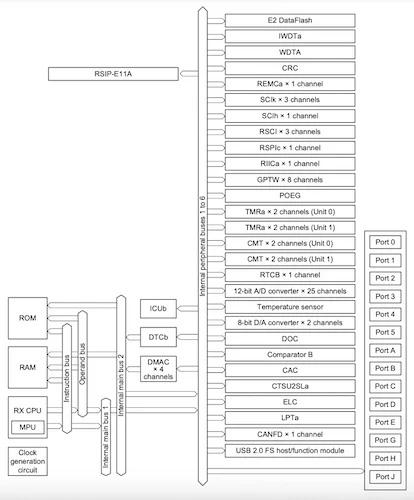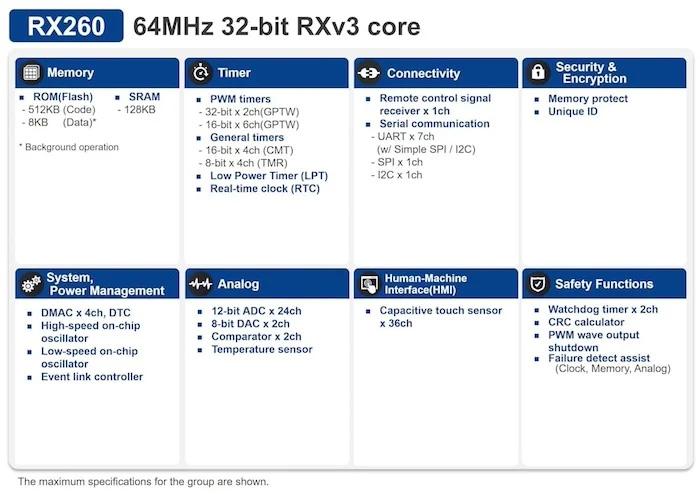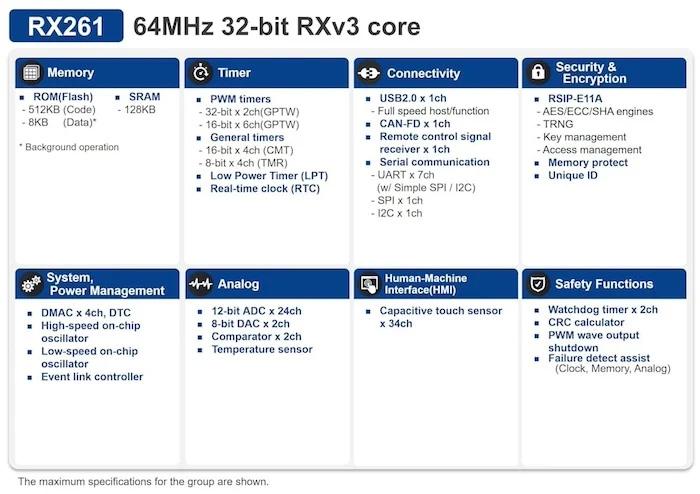
Renesas Rolls Out MCUs Aimed at Appliances and Building Automation
Renesas recently announced its new RX261/RX260 group MCUs for smart home systems, HVAC controls, or security infrastructure.
As appliances and building automation systems become more advanced, the demand for microcontrollers (MCUs) that combine power efficiency, computational performance, and enhanced security has surged. Modern automation requires devices that can process complex algorithms, manage multiple communication interfaces, and operate within constrained power budgets—all while maintaining secure data exchange.

The new RX261/RX260 MCUs.
Renesas developed the RX260 and RX261 groups of MCUs to deliver a balance of power efficiency and computational performance.
RX261/RX260 Group Compute
Renesas built the new MCUs around a 32-bit RXv3 CPU core with a maximum operating frequency of 64 MHz. The CPU supports advanced digital signal processing (DSP) capabilities with 32-bit multiply-accumulate instructions, a 16-bit multiply-subtract instruction, and a 32-bit floating point unit (FPU) compliant with the IEEE-754 standard.

Block diagram of the RX260 and RX261 groups.
On a lower level, the architecture uses a CISC Harvard model with a five-stage pipeline to execute instructions efficiently. Other architectural features include support for ultra-compact code with variable-length instructions and a built-in memory protection unit (MPU) for secure control over memory access.

RX260 MCU features.
In terms of memory, the devices feature up to 512 KB of on-chip Flash memory and 128 KB of SRAM. The Flash memory supports background operations, like concurrent read/write processes, which allows systems to perform frequent data storage without halting operations. With a capacity of 8 KB, the data Flash supports up to 1,000,000 program/erase cycles. Altogether, the MCU’s architecture allows it to achieve a 355 CoreMark at full speed, which Renesas claims is 2.5 times higher than competitive 64-bit solutions.
Efficiency and Security
Another highlight of the RX261/RX260 group MCUs (datasheet linked) is their power efficiency. Operating modes such as sleep, deep sleep, software standby, and snooze are designed to reduce power consumption, with a typical standby mode current draw as low as 1.01 µA. Additionally, the RX260/261 operates from a single 1.6 V to 5.5 V supply and features low power timers with a recovery time of 6.3 µs from standby. Meanwhile, the system clocks at 84 µA/MHz in high-speed operating mode.
Communication capabilities are also extensive, with up to 11 communication channels. These include USB 2.0 full-speed OTG support, CAN FD compliance, and multiple serial communication interfaces. The RX260/261 also supports a 12-bit ADC with a conversion time of 0.5 µs and 24 external channels, a two-channel DAC, a two-channel comparator, and a built-in capacitive touch sensing unit.

RX261 MCU features.
Finally, the RX260 and RX261 MCUs incorporate several security features. The system includes the Renesas Secure IP (RSIP-E11A) module, which provides hardware-based encryption capabilities, including AES128/256 symmetric encryption, ECC public-key cryptography, a true random number generator, and secure hashing algorithms such as SHA224 and SHA256.
Beyond the Silicon
As energy codes grow stricter and cyber threats more sophisticated, manufacturers must balance competing demands for processing power, efficiency, and security. The RX261/RX260 group points to an emerging trend where MCUs are becoming central orchestrators in smart systems rather than mere controllers. As more devices incorporate similar capabilities, we will likely see automation architectures shift from centralized to mesh-like configurations, where intelligence and decision-making are distributed throughout buildings.




